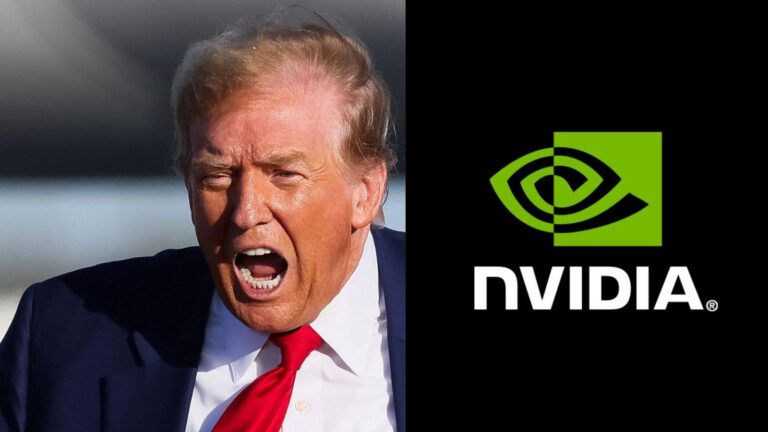Nvidia and AMD have agreed to pay 15% of their China chip sales revenues to the U.S. government, according to a report by the Financial Times. This unprecedented revenue-sharing arrangement marks a significant development in the ongoing technology and trade tensions between the world’s leading semiconductor manufacturers and U.S. regulatory authorities. The move is expected to impact the strategies of both companies in one of the largest and most competitive markets for advanced chip technology.
Nvidia and AMD to Remit Portion of China Chip Sales Revenue to US Treasury
Nvidia and AMD, two leading giants in the semiconductor industry, have agreed to remit 15% of their revenue generated from chip sales in China to the U.S. Treasury. This unprecedented move emerges amidst escalating trade tensions and aims to bolster U.S. government resources by tapping into the substantial revenues these companies earn in one of the world’s largest electronics markets.
The financial implications for both companies are significant, potentially affecting their pricing strategies and supply chains in the Chinese market. Key aspects of this agreement include:
- Mandatory payments calculated quarterly based on verified sales figures.
- Increased scrutiny over export controls and compliance procedures.
- Potential ripple effects on global semiconductor trade dynamics.
| Company | Estimated Annual Sales in China (USD) | Contribution to U.S. Treasury (15%) |
|---|---|---|
| Nvidia | $10 Billion | $1.5 Billion |
| AMD | $6 Billion | $900 Million |
Implications for Semiconductor Industry and Global Supply Chains
The decision requiring Nvidia and AMD to remit 15% of their China chip sale revenues to the US government marks a major shift in the semiconductor landscape, potentially reshaping global supply chains. Such financial obligations heighten operational costs for companies heavily invested in the Chinese market, pressuring them to reconsider manufacturing and sales strategies. This move could accelerate efforts to diversify supply chains away from China, as firms seek to minimize regulatory exposure and currency risk. Moreover, this policy might spur increased investment in domestic chip production initiatives within the US, as well as alliances with alternative markets in Southeast Asia and Europe.
Industry analysts warn this financial levying could disrupt the delicate balance of chip supply and demand, with ripple effects extending beyond pricing. Key implications include:
- Supply Chain Realignment: Potential relocation of production facilities to reduce dependency on China-centric operations.
- Cost Pressures: Increased production costs may be passed down to consumers or absorbed, impacting profit margins.
- Innovation and R&D Focus: Greater emphasis on accelerating domestic semiconductor technologies to lessen strategic vulnerabilities.
The table below outlines a simplified comparison of chip sale revenue allocations pre- and post-policy implementation:
| Region | Revenue Share Before (%) | Revenue Share After (%) |
|---|---|---|
| China Market | 100 | 85 (after 15% payment) |
| US Government | 0 | 15 (new levy) |
Strategic Responses for Tech Firms Navigating Increased US Regulatory Costs
Facing the imposition of a 15% levy on their China chip sales revenues, Nvidia and AMD exemplify the growing regulatory challenges tech giants must swiftly navigate. In response, companies are recalibrating operational strategies to maintain profitability amid mounting compliance costs. Measures include diversifying manufacturing footprints across more favorable jurisdictions, accelerating investments in domestic R&D to reduce dependency on contested exports, and enhancing supply chain resilience through regional partnerships.
Additionally, industry leaders are adopting robust policy engagement and compliance frameworks, leveraging legal expertise to interpret evolving regulations proactively. Key strategic responses include:
- Investment in alternative markets: Shifting focus towards emerging economies less impacted by US-China tensions.
- Enhanced lobbying efforts: Building coalitions to influence policy formulation and mitigate adverse impacts.
- Innovation acceleration: Prioritizing proprietary technology development to circumvent export restrictions.
| Strategic Focus | Expected Impact |
|---|---|
| Geographic Diversification | Lower regulatory exposure |
| Lobbying & Policy Advocacy | Improved regulatory clarity |
| R&D Investment | Increased technological independence |
To Conclude
As Nvidia and AMD prepare to comply with the United States government’s directive to contribute 15% of their China chip sale revenues, the move marks a significant escalation in the ongoing technology and trade tensions between the world’s largest economies. Industry analysts will be closely watching how this new financial obligation affects the companies’ operations and the broader semiconductor market in China. The development underscores the enduring geopolitical complexities shaping the global tech landscape, with implications for innovation, supply chains, and international business strategies going forward.




